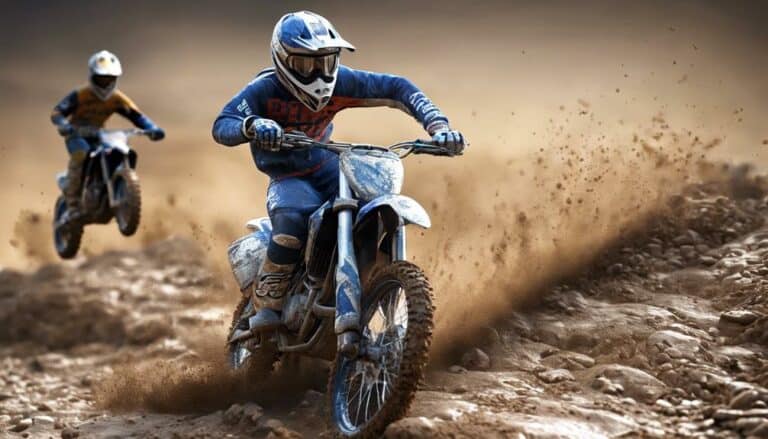When traversing through various terrains on your dirt bike, mastering the art of braking becomes paramount.
From loose gravel to muddy tracks, each surface demands a unique approach to guarantee maximum control and safety.
Understanding the nuances of front brake techniques, rear brake strategies, and the utilization of engine braking can greatly enhance your riding experience.
But what are the best practices for braking on these diverse terrains? Stay tuned to discover the expert tips that will elevate your dirt biking skills to the next level.
Key Takeaways
- Utilize front brake before corners and rear brake for stability on different terrains.
- Adjust braking pressure for optimal stopping power and control.
- Combine engine braking with front and rear brake techniques for enhanced performance.
- Practice weight transfer and body positioning for mastering advanced braking skills.
Front Brake Techniques
Properly utilizing the front brake on a dirt bike is essential for maximizing stopping power and control in various terrains. The front brake plays a critical role in your braking performance, providing up to 70% of the stopping power. By mastering front brake techniques, you can enhance your braking efficiency and overall control on different surfaces. When you apply the front brake correctly, the forks dive, improving traction and stability. Understanding how to manage your front tire grip and applying the right amount of pressure on the brake lever is key to braking effectively.
To brake effectively, consider using the front brake strategically before corners to help you maintain speed and control through the turn. This technique not only reduces your braking distance but also sets you up for a smoother and faster exit. By honing your front brake skills and learning how to control the front wheel with precision, you can enhance your overall riding experience and tackle various terrains with confidence.
Rear Brake Strategies
When switching from front brake techniques to rear brake strategies, focus on harnessing the rear brake's contribution to your dirt bike's stopping power effectively. The rear brake plays a significant role in your braking system, providing approximately 30% of the stopping power. To make the most of this component, consider the following strategies:
- Stability: Utilize the rear brake to help control the bike's stability, especially on uneven terrains.
- Prevent Skidding: Proper use of the rear brake can prevent skidding, allowing you to maintain traction and control.
- Braking Bumps: When encountering braking bumps, rely on the rear brake to help settle the bike and maintain a smoother ride.
- Moderate Pressure: Apply moderate pressure on the rear brake to avoid wheel lock-up while still effectively slowing down.
- Terrain Efficiency: Mastering rear brake techniques enhances your overall braking efficiency and control on various terrains.
Braking on Various Terrains
Exploring different terrains on a dirt bike requires adjusting your braking techniques to maintain traction and control effectively. When riding on loose or sandy terrain, apply both brakes gently to prevent skidding and maintain stability.
On hard-packed dirt or gravel, rely more on the front brake for stopping power and use the rear brake to keep your balance.
In muddy conditions, count on engine braking and the rear brake to avoid sliding and stay in control.
When faced with rocky terrain, modulate both brakes to smoothly navigate obstacles and sustain your balance.
Riding on wet surfaces demands a cautious approach — use a combination of both brakes to prevent skidding and make sure you stay in control.
Mastering Engine Braking
To master engine braking effectively on your dirt bike, understand that it occurs when the throttle is released without clutch engagement, utilizing the resistance of the engine to slow down the bike. When it comes to mastering engine braking, here are some key techniques to help you enjoy the ride:
- Downshifting: Prioritize downshifting before braking to maximize engine braking capabilities.
- Control: Use engine braking to control your speed effectively on different terrains.
- Traction: Engine braking is important for maintaining traction, especially when maneuvering tricky surfaces.
- Stability: Incorporate engine braking with other braking techniques for best control and stability.
- Front Brake: Combine engine braking with the front brake for enhanced braking power and control.
Advanced Braking Skills
Enhancing your dirt bike braking abilities requires mastering advanced techniques tailored to diverse terrains. To brake independently, understand the important role of weight transfer in effective braking.
Utilize engine braking to control speed smoothly, especially on varied surfaces like sand, mud, or rocks. Adjust your braking techniques accordingly to maintain braking stability and control over your bike.
Proper body positioning is essential for mastering advanced braking skills, ensuring you can navigate terrain variations with ease. Consistent practice is key to developing these skills, allowing you to confidently control speed and maneuver through challenging landscapes.
Conclusion
To sum up, remember to master the art of braking on different terrains with your dirt bike by practicing proper front and rear brake techniques, utilizing engine braking effectively, and maintaining proper body dynamics.
By honing your skills and staying consistent with training, you can conquer any terrain with control and confidence. Keep pushing your limits and perfecting your braking skills to reveal the full potential of your dirt bike performance.
Ride on, ready to conquer and control with confidence!

